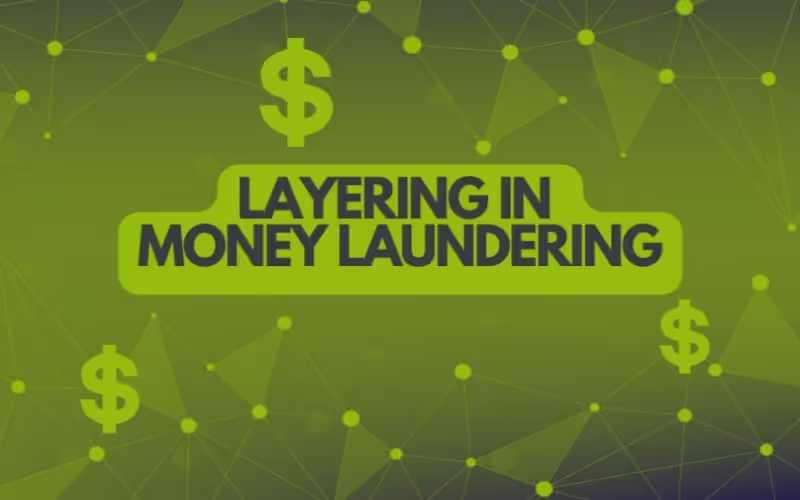
Layering in Money Laundering: What It Is And How It Works
The global financial system is infested with dirty money. And the layering stage of money laundering is the second step criminals embark on when cleaning it. It's a complex, sophisticated, and intriguing stage that aims to foil pursuit by financial crime fighters who want to stop it.
Money launderers use the following three stages to hide their illicit funds: placement, layering, and integration, costing the global economy $800 billion to $2 trillion annually.
Layering occurs after the placement step - when the black money enters the legitimate financial system. This is what the article will cover:
- What is Layering in Money Laundering?
- Basic Example of the Layering Stage of Money Laundering
- Complicated Techniques Used in the Layering Stage
- Cryptocurrencies & the Layering Stage of Money Laundering
What is Layering in Money Laundering?
In the layering stage of money laundering, criminals with illicit funds (and even lawful funds laundered for tax evasion) create a labyrinth puzzle between them and the dirty money.
But before we dig into the details, it's helpful to understand the criminals' motivation for doing it. The irrefutable fact is that anyone with illicit money strongly desires to distance themselves from where that money came from.
Dirty money entering the legitimate financial system, as in the placement stage, is insufficient. Why? Because the moment a government authority investigates, even years in the future, they know the money trail will lead to them.
It sounds complex - but you certainly don't need a Ph.D. in Applied Mathematics to understand it. The best way to look at it is like this:
Following the money trail would be simple if all the lights were on and arrows told you where to look next.
However, highly-skilled money launderers - often with insider knowledge - are experts at turning the lights off, moving the arrows around, and creating havoc. And that's where the confusion stems from. In the next section, we'll examine how all this plays out tangibly.
Basic Example of the Layering Stage of Money Laundering
In our blog post about the placement stage of money laundering, we learned how the Mexican arm of HSBC became the 'bank of choice' for drug cartels between 2006-2010.
Unfathomably, in a significant compliance breach, traffickers used custom-made boxes that perfectly fitted the dimensions of the tellers' windows at Mexico HSBC branches when depositing undetected dirty cash into accounts.
But what happened to the black money next?
HSBC's Money Laundering Scandal (Layering Stage)
The reality is this: All the illicit money obtained from the US illegal drug trade that entered the financial system via HSBC Mexico branches was layered in hundreds (if not thousands) of nefarious schemes.
But let's examine one example. And this case involves Colombian drug traffickers who were also using HSBC Mexico branches to launder money. This is what they did:
Steps:
- Smuggled US dollars to Mexico (profits from the illegal drug trade)
- Deposited the illicit cash into HSBC accounts via Mexico branches
- Wired the dirty money to businesses in the trafficker's network in the US (and elsewhere)
- The illegal funds were used by these businesses to purchase high-value consumer goods from legitimate companies (e.g., computers & washing machines)
- These consumer goods were sold to other businesses within the US in the trafficker's network
- Goods were then exported to Colombia and resold to wholesalers (at favorable prices) to generate clean cash
- Cash was then integrated back into the financial system through Colombian banks - with the appearance of legitimate transactions (import & sale of consumer goods)
The above steps, which created multiple innocuous-looking invoices, show how this scheme concealed the true origin of the illegal funds and made the dirty money appear legitimate.
The following section will examine additional techniques that add further layers, complications, and puzzles for financial crime fighters to solve.
Complicated Techniques Used in the Layering Stage
We already know that the layering stage of money laundering involves creating web-like financial puzzles that aim to conceal the illegal funds' origin. Black money moves through a series of wire transfers, invoice payments, and other financial transactions across borders to make them more challenging to trace.
Money launderers are using all of the below tactics, mostly in tandem, to achieve the above objective:
Smurfing & Structuring
The sanctions.io blog talked about smurfing & structuring in the layering stage of money laundering. Although different, both techniques involve breaking large amounts of illegal funds into smaller parts to minimize detection. In the HSBC Mexico case, traffickers wired funds to the US (and other jurisdictions) in smaller amounts and to numerous businesses within their illegal network to avoid detection.
False Invoicing
As discussed with the HSBC Mexico case, cartels bought and sold consumer goods to create invoices that appear legitimate. Criminal groups - with legitimate businesses within their network - may also issue false invoices for goods and services that don't exist. This technique creates a genuine-looking paper trail, but only illicit funds move around like chessboard pieces.
Trade-Based Money Laundering (TBML)
TBML is similar to false invoicing. Except, the goods do exist. Either more or less of the goods or services arrive to the buyer. This over-charging or under-charging of goods effectively means dirty money moves in the direction the criminal chooses.
According to Global Financial Integrity (GFI), fraudulent invoicing is the most significant component of illicit financial outflows.
Shell Companies & Off-Shore Bank Accounts
According to the FATF (Financial Action Task Force), anonymous shell companies are one of the most common tactics used in the layering stage of money laundering.
Shell companies are located in jurisdictions with stringent secrecy laws - making it harder for authorities to identify the UBO (Ultimate Beneficial Owner).
Criminals flow money through shell companies they control (for example, disguised as invoice payments) because it increases the likelihood of investigators meeting a dead end in the money trail. Off-shore bank accounts in 'havens' with strong secrecy ratings are also utilized.
To conclude, many more techniques exist for creating confusing layers in the money trail. For example, another method is converting dirty money into financial instruments (such as stocks) and later cashing out. Criminals constantly concoct new elaborate schemes - one reason catching them is so difficult.
Cryptocurrencies & the Layering Stage of Money Laundering
Crypto money laundering is now big business in the underworld. And in 2022, $23.8 billion in digital currency was transferred through illicit addresses, much of that in the layering stage.
Profits from cybercrime, where there is no physical cash and thus avoids the placement stage of money laundering, make up a large percentage of the enormous figure above.
But traditional cash-based crime, such as the illegal drugs trade and prostitution rings, still can take advantage of layering techniques found within crypto.
In our article about the placement stage of money laundering, we discussed how criminals can exchange dirty money (literally bags full of dollars) for crypto using, for example, Bitcoin ATMs with weaker compliance and unregulated crypto exchanges.
This crypto, like fiat currency, can be layered to conceal its origins - and later exchanged back into fiat money. Here are some of the ways criminals do it:
Mixers (also known as Tumblers or Blenders)
This technique pools multiple crypto transactions from various sources together before redistributing the funds to new addresses, often in smaller amounts, making it difficult to trace the origin of the funds. In early 2022, OFAC issued its first-ever sanctions on a virtual currency mixer for its role in money laundering.
Privacy Coins
Privacy coins like Monero (XMR) and Zcash (ZEC) are attractive to criminals layering illicit funds because they use cryptographic techniques and algorithms that make users anonymous. Stricter regulation is on the way. But like with fiat currency - money launderers will always identify jurisdictions with favorable laws.
Chain-Hopping
Chain-hopping is when criminal funds pass through multiple cryptocurrency blockchains (or coins) to conceal its origin and destination.
Learn More About Money Laundering
You can learn about the three stages of money laundering and what businesses should do to combat money laundering on the sanctions.io blog.
To find out more about ways to detect and prevent money laundering within your organization, contact sanctions.io for an obligation-free discussion. We enable intelligent AI-powered sanctions, PEP, and criminal watchlist screening for your AML, KYC & trade compliance screening needs.



